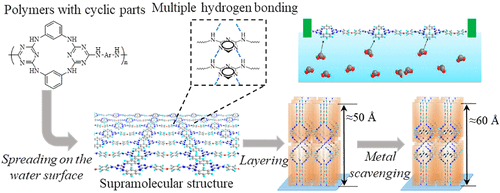Our official English website, www.x-mol.net, welcomes your feedback! (Note: you will need to create a separate account there.)
Polyguanamine Derivative-Based Supramolecular Assemblies with Multiple Hydrogen Bonding and Their Metal-Scavenging Abilities
Langmuir ( IF 3.9 ) Pub Date : 2020-04-02 , DOI: 10.1021/acs.langmuir.0c00283 Keito Fukushi , Haruka Maruyama , Yuji Shibasaki 1 , Atsuhiro Fujimori
Langmuir ( IF 3.9 ) Pub Date : 2020-04-02 , DOI: 10.1021/acs.langmuir.0c00283 Keito Fukushi , Haruka Maruyama , Yuji Shibasaki 1 , Atsuhiro Fujimori
Affiliation

|
Polyguanamine derivatives having cyclic moieties constituted by two phenyl and two triazine rings have been synthesized, and a supramolecular organization based on their multiple hydrogen-bonding ability was investigated. The obtained polyguanamine derivatives with cyclic moieties were transparent and amorphous in the bulk state and showed excellent mechanical strength emanating from multiple hydrogen bonds, owing to the abundant amino groups present in the structure. These polyguanamine derivatives formed stable monolayers at the air/water interface. The multilayers were transferred using the Langmuir–Blodgett method, and they formed highly periodic layered structures. To evaluate the metal scavenging ability of the cyclic moieties, the metal ions, Cd2+, Nd3+, and Pd2+, were introduced in the subphase. As a result, the cyclic moieties in the polyguanamine derivatives efficiently captured Cd2+, Nd3+, and Pd2+ metal ions. After the metal was captured, the layered structure of each organized film showed higher periodicity because of rearrangement. Moreover, the annular part had a cup-like structure, and the steric size effect of the ring influenced the metal scavenging.
中文翻译:

具有多氢键的基于聚胍胺衍生物的超分子组装及其金属清除能力
已经合成了具有由两个苯基和两个三嗪环构成的环状部分的聚胍胺衍生物,并且基于它们的多重氢键结合能力研究了超分子组织。所获得的具有环状部分的聚胍胺衍生物在本体状态下是透明且无定形的,并且由于结构中存在大量的氨基,因此显示出由多个氢键产生的优异的机械强度。这些聚胍胺衍生物在空气/水界面形成稳定的单层。使用Langmuir-Blodgett方法转移多层,它们形成了高度周期性的分层结构。为了评估环状部分的金属清除能力,金属离子Cd 2 +,Nd 3+和Pd 2+在子阶段中进行了介绍。结果,聚胍胺衍生物中的环状部分有效地捕获了Cd 2 +,Nd 3+和Pd 2+金属离子。捕获金属后,由于重新排列,每个有组织膜的层状结构显示出较高的周期性。此外,环形部分具有杯状结构,并且环的空间尺寸效应影响金属清除。
更新日期:2020-04-03
中文翻译:

具有多氢键的基于聚胍胺衍生物的超分子组装及其金属清除能力
已经合成了具有由两个苯基和两个三嗪环构成的环状部分的聚胍胺衍生物,并且基于它们的多重氢键结合能力研究了超分子组织。所获得的具有环状部分的聚胍胺衍生物在本体状态下是透明且无定形的,并且由于结构中存在大量的氨基,因此显示出由多个氢键产生的优异的机械强度。这些聚胍胺衍生物在空气/水界面形成稳定的单层。使用Langmuir-Blodgett方法转移多层,它们形成了高度周期性的分层结构。为了评估环状部分的金属清除能力,金属离子Cd 2 +,Nd 3+和Pd 2+在子阶段中进行了介绍。结果,聚胍胺衍生物中的环状部分有效地捕获了Cd 2 +,Nd 3+和Pd 2+金属离子。捕获金属后,由于重新排列,每个有组织膜的层状结构显示出较高的周期性。此外,环形部分具有杯状结构,并且环的空间尺寸效应影响金属清除。



























 京公网安备 11010802027423号
京公网安备 11010802027423号